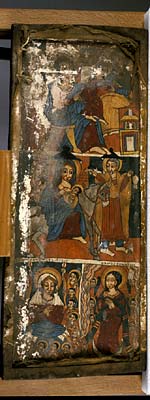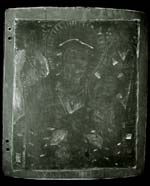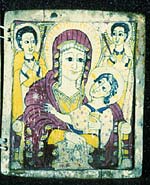
Right Panel
Before

Icon
Ethiopian Orthodox style
98-3-3
Science: Conservation Introduction
The six icons in the National Museum of African Art's collection (which date from the 17th - 19th century) were the focus of a yearlong project to research the materials and techniques of manufacture and to undertake conservation treatment. This technical study is one of the first to scientifically identify and document the materials used to paint Ethiopian icons. The results of this research can be used to support historical descriptions of the materials and techniques used (Weihs, 1973; Chojnacki, 1973, 2000).A variety of analytical methods were employed to study the support materials, artistic composition of the paintings, paint binder and pigments utilized. Please refer to the Glossary of Technical Analyses below for descriptions and definitions of the methods utilized. A Treatment Case Study also follows which describes the treatment undertaken on the most damaged icon in NMAfA's collection, the left panel of 98-3-3. Finally, a Select Bibliography follows for those interested in further research on this topic. Erica James, painting conservator, executed this conservation research project which was generously funded by the Samuel H. Kress Foundation.
Right Panel
After

Icon
Ethiopian Orthodox style
98-3-3

94-21-1
right panel, x-ray
Science: How the Ethiopian Icons Were Fabricated
Each NMAfA icon is constructed of wood planks (typically from olive or wanza trees) cut radially. The individual panels of an icon are split from the same board. Beginning in the 17th century often a cotton cloth (readily visible around the perimeter of 98-3-1) was adhered to the wood to provide an even surface for painting on the roughly hewn boards. A white ground layer of gesso (gypsum) was applied in several coats over the cloth-covered panels. The composition was then drawn on the ground layer. Infrared photography, which records carbon-based materials, and X-radiography, which records the relative densities of materials, were employed to detect any changes in the image from the underdrawing to the final painting. No such changes were noted for any of the icons.

Example of
Infrared (IR) photography

Spectra of chemical elements present in sample of green earth pigment from 94-21-1 (detail)
Science: The Ethiopian Icon Painter's Palette
The paint consists of finely ground pigments dispersed in an animal glue binder known as distemper. This is the same type of binder described in historical accounts of icon painting methods (Weihs, 1973).
The pigments were identified as mostly mineral pigments, which comprised the narrow palette commonly available during that time period. Elemental analysis undertaken identified the individual chemical elements present in the pigments enabling precise chemical identification of each pigment. Red was created predominantly with cinnabar (HgS) or its synthetic counterpart vermillion; on icon, 98-3-3, madder lake dye (an anthraquinone dye) was also found in the dark red areas. White was created with gypsum (CaSO4). Black was achieved with charcoal (carbon). Yellow was made with orpiment (As2S3). Blue was made with indigo (C16H10N2O2); on icon 98-3-1, small quantities of Prussian blue (Fe4(Fe[CN]6)3) were also detected and on another, 94-21-1, trace amounts of smalt (K and Co oxide glass) were mixed with the indigo. Green was created with a mixture of indigo and orpiment; icon 94-21-1 also had small quantities of green earth (Mg, Fe, K, and Al silicates) mixed with the orpiment and indigo.

Chemical elements present in sample of green earth pigment from 94-21-1.